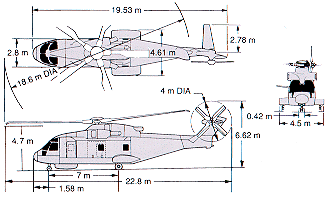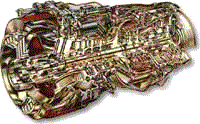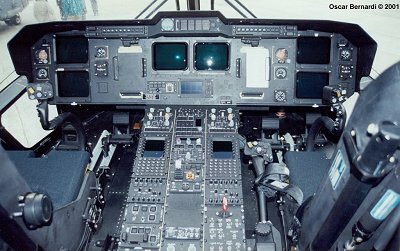Structure and Systems
Structure
The EH101 is mostly made of conventional materials, although composites are used in some areas. The rotor hub has been designed on the multiple load path concept, with composite plates surrounding a metal core in such a way that the plates carry centrifugal forces while a metal-hub centre arm carries the bending loads. In the event of an arm failure, the composite plate retains the blade and allows the helicopter to stay airborne. The aircraft's windscreen is formed of glass-faced ploycarbonate glazed to the airframe, and is designed to withstand a 1kg bird strike at over 300 kph. The tail unit is formed almost entirely of composites with carbon-fibre bulkheads, carbon-fibre/Kevlar fin spars and Kevlar/Nomex honeycomb sandwich skins.
Dimensions
Overall folded size of the EH101 is only marginally larger than that of the SH-3 Sea King, but because of the arrangement of the undercarriage the 101 is able to use less deck space than its predecessor.
| Dimensions | Weights | ||||
|---|---|---|---|---|---|
| Length, rotors turning | : | 22.8 m | Basic empty weight, ASW version | : | 9080 kg |
| Height, overall | : | 6.63 m | Basic empty weight, utility version | : | 8910 kg |
| Length, fuselage | : | 19.63 m | Empty weight, RAF version | : | 10250 kg |
| Length, folded | : | 15.85 m | Cargo/fuel weight, RAF version | : | 4350 kg |
| Main rotor diameter | : | 18.6 m | Max T/O weight | : | 14600 kg |
| Tail rotor diameter | : | 4.0 m | |||
| Cabin length | : | 6.5 m | |||
| Cabin width | : | 2.39 m | |||
| Cabin height | : | 1.82 m | |||
 |
 |
Engines
 The development aircraft were powered by three General Electric CT-6 turboshafts. Production aircraft for the RAF and RN are equipped with the Rolls Royce Turbomeca RTM 322. The Merlin HC.3 has the RTM 322-02/8, which has a maximum continuous rating of 1342 kW. The RTM 332-01s used by Royal Navy Merlins are slightly less powerful. Italian Navy and Canadian Armed Forces aircraft have the General Electric T700-GE-T6A turboshaft instead of the RTM-322.
The development aircraft were powered by three General Electric CT-6 turboshafts. Production aircraft for the RAF and RN are equipped with the Rolls Royce Turbomeca RTM 322. The Merlin HC.3 has the RTM 322-02/8, which has a maximum continuous rating of 1342 kW. The RTM 332-01s used by Royal Navy Merlins are slightly less powerful. Italian Navy and Canadian Armed Forces aircraft have the General Electric T700-GE-T6A turboshaft instead of the RTM-322.
In all three versions the transmission cannot handle the full output of all three engines, but if one fails the remaining two engines have sufficient power to keep the helicopter flying.
The RAF's utility version will be able to carry over 3200 kg of fuel, plus an overload tank in the cabin. It will also be able to carry a bolt-on refuelling probe. The naval version will have a Hovering In-Flight Refuelling (HIFR) point in the cabin, just aft of the cargo door.
Rotor Blades
 The EH101 is fitted with special helicopter blades made out of glass and carbon fibres which have been woven and bonded together. The blades are manufactured with new shaped tips, which were developed from the British Experimental Rotor Programme (BERP). The helicopter has five main blades, which provide a great deal more lift than conventional blades.
The EH101 is fitted with special helicopter blades made out of glass and carbon fibres which have been woven and bonded together. The blades are manufactured with new shaped tips, which were developed from the British Experimental Rotor Programme (BERP). The helicopter has five main blades, which provide a great deal more lift than conventional blades.
Rear Ramp
The military utility version of the EH101 has a rear loading ramp.

Avionics
Excepting the naval/military mission equipment, the EH101 cockpit is common to all versions. Six 18x15cm multifunction colour displays replace the traditional dials. The avionics system is based on two MIL stdnb 1553B digital databuses which link the basic aircraft management system and mission systems. The latter, based on dual redundant mission computers, handles all sensors and displays and controls the mission bus.

Merlin cockpit

CH-149 Cormorant cockpit

RDAF EH101 cockpit
The EH101 is fitted with Health and Usage Monitoring (HUM) equipment, which will monitor aspects of rotor head, transmission and mission performance, and presumably warn the pilot of any problems. HUM and the mission systems will combine to reduce crew workload, an essential requirement given the long and complex missions which the helicopter will undertake.
The Ferranti Blue Kestrel radar is fitted to the underside of the Royal Navy's aircraft. Blue Kestrel's 360° scan and multiple target-tracking facility make it far more capable than the the Sea Spray radar fitted to the Lynx. British aircraft will also carry "Orange Reaper" ESM equipment. The ASQ903 acoustic processor will process data returned by dunking sonor or sonobuoys.
Royal Navy Merlins are equipped with the Thomson Marconi Sonar FLASH (Folding Light Acoustic System for Helicopters) active dipping sonar. This comprises a submersible unit with a low frequency transmitter, and a receiving array of 12 folding arms. FLASH is suitable for both deep and shallow water operations, and is capable of operating at depths down to 700m.
The Italian Navy Helicopter Early Warning (HEW) version of the aircraft is equipped with a pulse-doppler surveillance radar and APS-784 antenna housed in a 3m diameter radome. This is able to detect and track multiple air targets even if embedded in ground or sea clutter, track surface targets and perform real-time surveillance of air and surface threats. Secondary maritime roles include over-the-horizon targeting and surveillance, AsuW and search and rescue. The mission sensors are controlled and integrated through the Mission Computer System (MCS), the core of which comprises two Mission Computer Units (MCUs).
The EH101 has a BAe ring laser gyro as its primary navigation aid. It also has the Plessey PA5015 radar altimeter. RN aircraft carry a Cossor GPS receiver.
Royal Air Force Merlin HC.3s have an enhanced Defensive Aids Suite (DAS), incorporating a passive (IR) missile warning system, a GEC-Marconi Sky Guardian 2000 radar warning receiver, a Hughes Danbury laser detection system and a Tracor ALE-47 countermeasures dispensing system. The DAS is designed to reduce crew workload; close-range, high-speed threats typical of the low level regime will be dealt with rapidly and with minimal crew interaction.
Aircraft for the Portugeuse Air Force, and Royal Danish Air Force, will be equipped with the FLIR Systems Inc. Star SAFIRE II thermal imaging system.
Royal Navy Merlins are to receive a sophisticated Electro-Optics and InfraRed (EO/IR) surveillance sensor developed by Lockheed Martin to give accurate, real-time information and positive identification against small, difficult to detect targets. The EO/IR pod will be temporarily mounted on an existing weapon carriage pylon on the side of the helicopter.
Airborne mine-countermeasures KH101s for the Japanese Maritime Self-Defense Force will be equipped with the EDO Organic Airborne and Surface Influence Sweep (OASIS) mission system. OASIS will provide a rapid response sweeping capability against bottom and moored acoustic and magnetic or combination acoustic/magnetic influence mines.
OASIS comprises six major components: the Towed Body, the Magnetic Influence Subsystem, the Acoustic Influence Subsystem, the Control/Monitoring and Power Subsystem, the Common Console (CC) OASIS Software, and the Tow Cable/CC Interface. The towed body houses the magnetic and acoustic subsystems and mechanical assemblies. It is hydrodynamically stable while being towed in a straight course as well as when the aircraft is making turns. The towed body measures its tow depth and its height above the bottom. It uses this data to position itself at a depth where sweeping will be most effective. The tow cable provides power distribution for all of the components in the towed body and provides communication with the CC. The towed body has a means of being located should it be jettisoned while being towed.
Performance
| Speed, cruise | : | 280 kph |
| Speed, max | : | 309 kph |
| Service ceiling | : | 4572 m |
| Rate of climb | : | 10.2 m/sec |
| Range, 30 pax + reserves | : | 925 km |
The EH101/Type 23 Frigate weapon system has been designed to provide maximum operational efficiency by reducing crew workload while maintaining a very high state of readiness and aircraft availability. Coupled with these attributes, the Royal Navy's reduced manning philosophy has driven the cockpit design towards operation by a single pilot. From a pilot's standpoint, the aircraft is fully capable of being flown solo. The handling qualities are exceptional throughout the flight envelope, the autopilot modes permit hands-off flight for most of the mission, and the avionics are in some cases triple redundant with benign failure modes.
EH101 will be able to operate in sea state 6, in up to 50 kt cross winds, to allow its parent Type 23 frigate to continue monitoring its towed sonar array without the need to turn into wind. Once on deck, the helicopter is made fast by engaging a rapid securing device, the harpoon, in a grid on the deck, while the rotor system can generate negative thrust. The harpoon interfaces with a semi-automatic handling system for aircraft moves and weapon loading.
Weapons
The naval EH101 is able to carry four Stringray or similar lightweight torpedoes, and also the Sea Skua missile.
| <<< Origins | Top | Development >>> |
